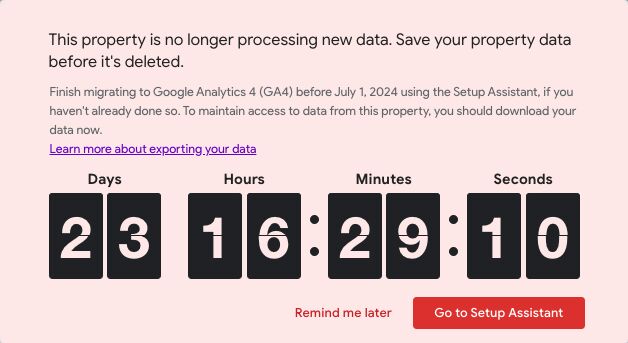
June 30th Deadline: Don’t Lose Your Historic Data! How to Export Data from Universal Analytics
It’s June, and another Google-imposed deadline is looming for digital marketers on July 1st. You might still be exhausted from the constant reminders about Google Analytics 4 (GA4) last year. You might find yourself relying more on other forms of data outside GA. But this latest change is one you still need to pay attention to—export data from universal analytics before it’s too late.
If you’ve logged into a Universal Analytics (UA) property lately, you’ve been greeted by a delightful new doomsday clock. This time around, it’s not about UA properties no longer reporting new data (that was last year). This time, it’s about UA properties no longer being accessible whatsoever after the week of July 1st, 2024. This means you will no longer be able to view historical UA data, and it will disappear forever into the void, so you want to export data from universal analytics before it is too late.
Here’s what’s at stake when you lose historical web analytics data:
- Inability to measure future performance based on past benchmarks
- Less context when building your next website
- Loss of institutional knowledge for new staff and partners
Thankfully, there are a few simple steps that nonprofits can take to preserve their historical UA data:
-
-
- Sign into Google Analytics
- Go into each Universal Analytics property
- Open each relevant Report in the sidebar
- Adjust the timeframe as needed (at least the last 3-5 years)
- Select “Export” in the upper right-hand side. Choose Google Sheets, Excel, or CSV as the format
- Upload each document to a safe and secure cloud storage platform and clearly label it so other staff can find it
-
For bonus points, use a data warehouse platform like Google’s BigQuery to store and combine the data with fresh numbers from GA4 and other sources. But ensuring you’ve exported all essential data points and safely saved the files away is a great starting point.
Remember: More data ≠ better results.
There’s such a thing as too much of a good thing, and data is no exception. But this isn’t about hoarding data for data’s sake. It’s about picking a few key points that are a.) fairly reliable indicators of success and b.) match apples-to-apples with sources you now use.
Here are a few data points to save:
Sessions
Users
Pageviews
Bounces
Bounce Rate
Avg. Time Spent on Site
Avg. Session Duration
Conversions/Goals (only if reliably tracked)
Capture raw numbers for each stat and also use dimensions to break them down by source/medium/campaign and page name/URL.
All Google Analytics data, UA and GA4 alike, should be seen as directional and not the truth. That’s what your first-party data is for. However, retaining historical records like these is essential because of how long your organization has likely been tracking with Google Analytics.
You never know what questions will come up in the future that your past data may be able to answer. In their classic 80’s power ballad, Cinderella once said, “Don’t know what you got ’til it’s gone.” Make sure you save this data for posterity’s sake. Your future self will thank you.
If you need help exporting or importing your data, please reach out.